After the biggest anti-Trump protests since the 2017 Women’s March, many major media outlets seemed intent on downplaying the size and significance of the massive demonstration of opposition.
The Hands Off! protests took place on April 5 in 1,400 locations across the country, with solidarity rallies in Europe and Canada. Volunteer organizers said the events were aimed at opposing billionaire government and corruption; cuts to Social Security, Medicaid and other vital programs; and attacks on immigrants, trans people and other vulnerable groups. At a conservative minimum, hundreds of thousands of people turned out to resist the Trump administration’s many assaults on democracy; organizers estimate the total reached into the millions.
Burying the news
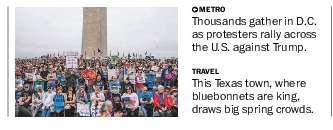
The Washington Post (4/6/25) relegated protesters “across the US” to the Metro section.
Despite the scale and significance of the protests, neither the New York Times nor the Washington Post had stories about them on their front pages the next day.
The Washington Post (4/6/25) had a thumbnail at the bottom of the front page with the blurb “Metro: Thousands gather in DC as protesters rally across the US against Trump.”
The New York Times (4/6/25) had a photo below the fold that was captioned: “A Day of Protest: People gathered around the country, including in Asheville, NC, to voice opposition to Trump administration policies. Page 18.”
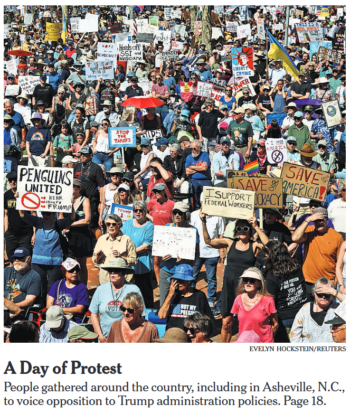
“People gathered around the country” was how the New York Times (4/6/25) downplayed the massive wave of protest.
A Times blurb promoting the story in a roundup of stories about “The Trump Administration’s First Hundred Days” minimized the scale and seriousness of the event:
Anti-Trump Protests: Demonstrators packed the streets in several cities to bemoan what they considered a lack of strong opposition to the president and his policies.
The verb “bemoan” is clearly belittling, and the focus of both organizers and participants was obviously on Trump (and Musk), not on the weakness of their opponents. And since when is 1,400 “several”?
The downplaying of the story couldn’t be explained by a lack of audience interest; indeed, people seemed extremely eager to hear about the protests. The protest coverage buried in the Times‘ print edition was the paper’s most-clicked article online that day, according to the paper’s Morning newsletter (4/7/25).
Little broadcast coverage
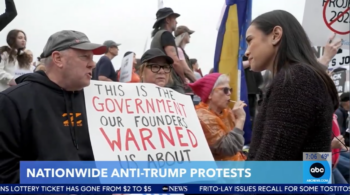
ABC‘s Good Morning America (4/6/25) offered protesters a few soundbites to speak for themselves.
The major broadcast networks gave the massive protests only passing coverage in most of their programming. On ABC, World News Tonight (4/5/25) gave only 20 seconds to a correspondent in Washington, DC, to explain the signs she was seeing. The network’s morning show, Good Morning America (4/6/25), offered a bit more, with a few soundbites given to protesters to speak for themselves. In a recent FAIR study (4/4/25) of protest coverage, ABC stood out for its blackout of nationwide anti-Trump protests that, even before this past weekend, already outnumbered protests in the same time period during Trump’s first term.
CBS Face the Nation (4/6/25) told viewers that “tens of thousands of people took to the streets yesterday from Washington, DC, to Minnesota and Columbus, Ohio, protesting many of Trump’s policies, Elon Musk and tariffs.” CBS Weekend News (4/6/25) included a short description of the protests only in the context of Trump’s tariffs, airing a soundbite of a protester speaking against them. CBS Sunday Morning (4/6/25) had another, even briefer mention of the protests, in an interview with Sen. Bernie Sanders.
A report on NBC Nightly News (4/5/25) mentioned “huge turnouts” and “protests in nearly every state.” The item featured several short soundbites from protesters. Meet the Press (4/6/25) also mentioned the protests briefly, with images.
Undercounting dissent
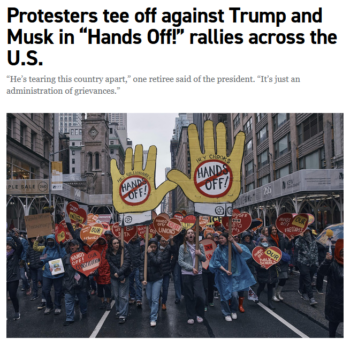
AP (via Politico, 4/5/25) reported that “thousands of protesters assailed Trump.”
NPR All Things Considered (4/5/25) told listeners that “thousands” gathered to protest Trump and Musk. So did the Associated Press (4/5/25)—whose credibility in the crowd-counting department could be judged by the article’s claim that the 2017 Women’s March also only saw “thousands.” (An effort at the time by the Washington Post to tally the US participants came up with a range of 3 million to 5 million—2/7/17.)
ABC World News Tonight (4/5/25) announced that “thousands” gathered on the National Mall in DC.
Over an otherwise commendable piece that compiled interviews with protesters in 11 cities and towns across the country, a USA Today subhead (4/5/25) also estimated “thousands.” It did so despite the fact that the piece led by reporting that “tens of thousands of people are gathering Saturday at rallies across the country”—itself a clear underestimate. The piece later explained that “more than 500,000 people have RSVP’d to attend” the protests, and that “protesters stretched as far as the eye could see along the National Mall and the crowd had been flowing toward the base of the Washington monument for hours.”
Given that there were some 1,400 separate protest events, it’s laughable to suggest that only “thousands” attended. Even if only 10 people showed up to each event, you’d have “tens of thousands”—but every event the paper reported on from small towns and cities (like Stuart, Florida) had at least several hundred if not thousands, while the DC and NYC events appeared to have at least 100,000 participants apiece (American Crisis, 4/8/25). Boston’s protest was reported locally to have involved “nearly 100,000” (CBS‘s WBZ, 4/6/25; NBC Boston, 4/7/25).
It would not be difficult for news organizations with resources like the national newspapers or major TV networks to produce credible estimates of crowd numbers at significant events. The fact that they don’t bother to do so reflects the scant importance these outlets place on the role of protests in the democratic process. Corporate media journalists are apt to regard protesters as akin to spectators rushing onto the field during a game, interfering with an activity best left to professionals.
Better reporting?
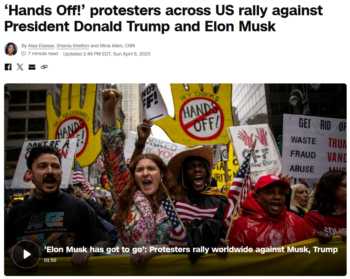
CNN.com (4/5/25; “updated” 4/6/25) edited this piece to change an initial “millions of people took part in protests” to a ridiculous “scores.”
CNN stood out among major corporate outlets for not underestimating the size and scope of the protests, with coverage of the protests in most of its shows over the weekend. The network repeatedly cited organizers’ estimates of at least 1,400 protest events across all 50 states, totaling “millions” of attendees (e.g., CNN This Morning, 4/6/25; CNN Inside Politics, 4/6/25). CNN correspondents in multiple US cities described the messages they heard and saw, and they also interviewed protesters on-air to let them speak for themselves.
CNN‘s online account (4/5/25) of the protests, however, originally reported that “millions of people took part in protests against President Donald Trump and Elon Musk across all 50 states and globally on Saturday,” but was stealth-edited on April 6 to ludicrously claim that “scores of people took part in protests.” We would be interested in hearing CNN‘s explanation for this self-evidently absurd alteration.
On CNN‘s Newsroom (4/6/25), as an indication of heightened interest in Trump opposition, senior data reporter Harry Enten pointed out that Google searches for the word “protests” were
up 1,200% versus a year ago…. We see that the percent in number of folks who are searching for protests, interested in going out in those protests is finally matching what we saw in January of 2017, if not exceeding it.
Axios (4/5/25) also reported organizers’ “millions” estimate, including their 500,000 RSVPs and their reports from the field that turnout was far exceeding those RSVPs. (For instance, they reported getting 2,000 RSVPs for Raleigh, NC, where they ultimately saw some 45,000 in attendance.)
Some local papers in the Gannett chain (which also owns USA Today) usefully offered readers information about the protests planned for their states before they took place (e.g., Columbus Dispatch, 4/2/25; Florida’s TCPalm.com, 4/5/25). These stories included why people were protesting, and the times and locations of every scheduled Hands Off! protest in their respective states.
Such coverage treats readers as citizens, and protesting as a basic part of a democratic system—not as an inconsequential sideshow, which is how it’s generally presented in corporate media.
This content originally appeared on FAIR and was authored by Julie Hollar.